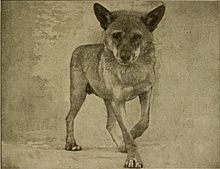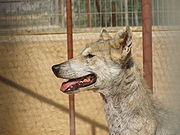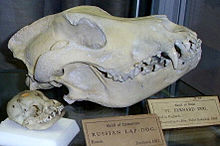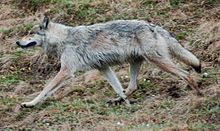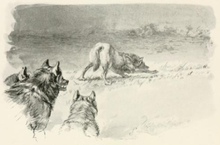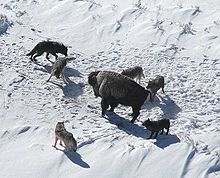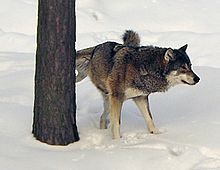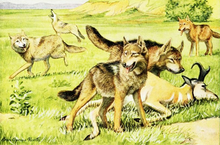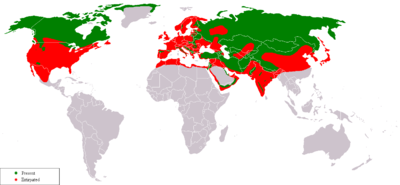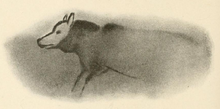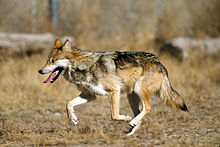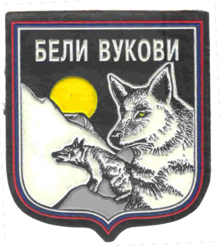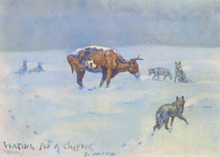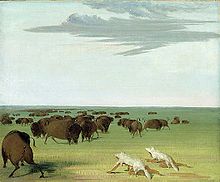
Gray wolf
About this schools Wikipedia selection
SOS Children have produced a selection of wikipedia articles for schools since 2005. Click here for more information on SOS Children.
| Gray wolf Temporal range: Middle Pleistocene–Recent |
|
|---|---|
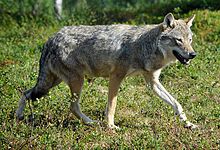 |
|
| Eurasian wolf (Canis lupus lupus), Polar Zoo, Norway. | |
| Conservation status | |
 Least Concern ( IUCN 3.1) |
|
| Scientific classification | |
| Kingdom: | Animalia |
| Phylum: | Chordata |
| Class: | Mammalia |
| Order: | Carnivora |
| Family: | Canidae |
| Subfamily: | Caninae |
| Tribe: | Canini |
| Genus: | Canis |
| Species: | C. lupus |
| Binomial name | |
| Canis lupus Linnaeus, 1758 |
|
| Subspecies | |
|
39 ssp., see Subspecies of Canis lupus |
|
 |
|
| Range map. Green, present; red, former. | |
The gray wolf or grey wolf (Canis lupus) is a species of canid native to the wilderness and remote areas of North America, Eurasia, and North Africa. It is the largest member of its family, with males averaging 43–45 kg (95–99 lb), and females 36–38.5 kg (79–85 lb). It is similar in general appearance and proportions to a German shepherd, or sled dog, but has a larger head, narrower chest, longer legs, straighter tail and bigger paws. Its winter fur is long and bushy, and predominantly a mottled gray in colour, although nearly pure white, red, or brown to black also occur.
Within the genus Canis, the gray wolf represents a more specialised and progressive form than its smaller cousins (the coyote and golden jackal), as demonstrated by its morphological adaptations to hunting large prey, its more gregarious nature and its highly advanced expressive behaviour. It is a social animal, travelling in nuclear families consisting of a mated pair, accompanied by the pair's adult offspring. The gray wolf is typically an apex predator throughout its range, with only humans and tigers posing a serious threat to it. It feeds primarily on large ungulates, though it also eats smaller animals, livestock, carrion, and garbage.
The gray wolf is one of the world's most well researched animals, with probably more books written about it than any other wildlife species. It has a long history of association with humans, having been despised and hunted in most agricultural communities due to its attacks on livestock, while conversely being respected by some Native American tribes. It is the sole ancestor of the dog, which was first domesticated in the Middle East. Although the fear of wolves is prevalent in many human societies, the majority of recorded attacks on people have been attributed to animals suffering from rabies. Non-rabid wolves have attacked and killed people, mainly children, but this is unusual, as wolves are relatively few, live away from people, and have been taught to fear humans by hunters and shepherds. Hunting and trapping has reduced the species' range to about one third[ clarify], though its still relatively widespread range and stable population means that the species is not threatened at a global level, and is therefore classified by the IUCN as Least Concern.
Etymology
The English word "wolf" stems from the Old English wulf, which is itself thought to be derived from the Proto-Germanic *wulfaz, from the Proto-Indo-European root *wlqwos/*lukwos. Old English literature contains several instances of Anglo-Saxon kings and warriors taking on wulf as a prefix or suffix in their names. Examples include Wulfhere, Cynewulf, Ceonwulf, Wulfheard, Eanwulf, Wulfmeer, Wulfstan and Aethelwulf. Wolf-related names were also common among pre-Christian Germanic warriors: Wolfhroc (Wolf-Frock), Wolfhetan (Wolf Hide), Isangrim (Grey Mask), Scrutolf (Garb Wolf), Wolfgang (Wolf Gait) and Wolfdregil (Wolf Runner).
Local and indigenous names
| Linguistic group or area | Indigenous name |
|---|---|
| Ainu | Seta |
| Albanian | Ujku |
| Arabic | ذئب (the’b) |
| Arapaho | Haqihana |
| Caddo | Tasha |
| Chinese | 狼 (láng) |
| Cornish | Bleit |
| Cree | May-hee'-gan |
| Croatian | Vuk |
| Czech | Vlk |
| Danish/ Norwegian | Ulv |
| Dutch/English/German | Wolf |
| Estonian | Hunt, susi |
| Finnish | Susi |
| French | Loup |
| Greek | Λύκος (lukos) |
| Gujarati | ના○ (Bagad) |
| Hindi | Bheriya, gúng, hondár, nekra, bighána |
| Hungarian | Farkas |
| Inuktitut | ᐊᒪᕈᖅ (amaruq) |
| Irish Gaelic | Faol, faol-chu |
| Italian | Lupo |
| Japanese | オオカミ(狼) (ōkami), ヤマイヌ(豺、犲、山犬) (yamainu) |
| Kashmiri | Ratnakin |
| Ladakhi | Chanco |
| Latvian | Vilks |
| Lithuanian | Vilkas |
| Mongolian | ᠴᠢᠨᠤᠠ / Чоно (chono) |
| Navajo | Maicoh |
| Nunamiut | Amaguk |
| Ogallala Sioux | Shunk'-ah mah-nee'-tu |
| Ojibwe | My-in'-gan, kit'-chi my-in'gan |
| Persian | گرگ (gorg) |
| Polish | Wilk |
| Portuguese/Spanish | Lobo |
| Romanian | Lup |
| Russian | Волк (volk) |
| Scottish Gaelic | Madadh, madadh allaidh |
| Sindh | Bagyár |
| Slovak | Vlk dravý |
| Slovenian | Volk |
| Swedish | Varg |
| Telugu | Toralú |
| Turkish | Kurt |
| Welsh | Bleidd |
| Yankton Sioux | Soŋ toke cha tuŋ-ka |
Evolution and taxonomy
Origins
Ancestry
The species' most likely ancestral candidate is Canis lepophagus, a small, narrow skulled North American canid of the Miocene era, which may have also given rise to the coyote. After the extinction of the large bodied Borophaginae family, C. lepophagus developed into a larger, broader-skulled animal. Fossils of this larger form of C. lepophagus found in northern Texas may represent the ancestral stock from which true wolves derive. The first true wolves began to appear at the end of the Blancan North American Stage and the onset of the early Irvingtonian. Among them was C. priscolatrans, a small species closely resembling the modern-day red wolf, which colonised Eurasia by crossing the Bering land bridge. The new Eurasian C. priscolatrans population gradually evolved into C. mosbachensis, which closely resembled modern wolves found in the Arabian Peninsula and South Asia, which were once distributed in Europe in the early Quaternary glaciation until about 500,000 years ago (see Subspecies). C. mosbachensis subsequently evolved in the direction of C. lupus.
Subspeciation
MtDNA studies have shown that there are at least four distinct gray wolf lineages: the most ancient is that of the African wolf (native to North, West, and East Africa), which is thought to have originated as early as the Middle to Late Pleistocene. All other lineages occur together in the Indian Subcontinent, the oldest of which is the Himalayan wolf (native to the Himalayan region of eastern Kashmir, Himachal Pradesh, parts of Tibet and eastern Nepal), which is thought to have originated 800,000 years ago, when the Himalayan region was going through major geologic and climatic upheaval. The peninsular Indian wolf, C. l. pallipes, likely diverged from the Himalayan wolf 400,000 years ago. The youngest wolf lineage in India is represented by C. l. chanco (native to the northwestern Himalayan region of Kashmir), which originated 150,000 years ago. This last lineage, known as the Holarctic clade, expanded into Europe and North America, as shown by it sharing genetic markers with domestic dogs, European and North American wolves.
The now extinct Japanese wolves were descended from large Siberian wolves which colonised the Korean Peninsula and Japan, before it separated from mainland Asia, 20,000 years ago during the Pleistocene. During the Holocene, the Tsugaru Strait widened and isolated Honshu from Hokkaidō, thus causing climatic changes leading to the extinction of most large bodied ungulates inhabiting the archipelago. Japanese wolves likely underwent a process of island dwarfism 7,000–13,000 years ago in response to these climatological and ecological pressures. C. l. hattai (formerly native to Hokkaidō) was significantly larger than its southern cousin C. l. hodophilax, as it inhabited higher elevations and had access to larger prey, as well as a continuing genetic interaction with dispersing wolves from Siberia.
Colonization of North America
Canis lupus colonized North America during the late Rancholabrean era. The larger Canis dirus was already established there, but it became extinct 8,000 years ago, after the large prey it relied on disappeared. Competition with the newly arrived gray wolf for the smaller and swifter prey that survived may have contributed to its decline. With the extinction of the dire wolf, the gray wolf became the only large and widespread canid species left. The North American recolonisation likely occurred in several waves, with the most distinctive populations occurring in the periphery of the range. These populations ( C. l. arctos on the high arctic islands, C. l. lycaon in the eastern forests, and C. l. baileyi in the far south) may represent survivors of early migrations from Eurasia. C. l. baileyi and C. l. lycaon display some primitive traits and systematic affinity to one another. Fossil remains from the late Pleistocene of large bodied wolves similar to C. l. arctos and C. l. albus occur in coastal southern California, indicating that large North American gray wolf subspecies were once widespread, and may have been driven southward by glaciation, though wolves no longer reside there. Fossils of small bodied wolves similar to C. l. baileyi have been found in a range encompassing Kansas and southern California. This indicates a late Pleistocene population flux, in which large, Arctic forms of wolf moved farther south, with smaller, warmth adapted wolves expanding as the climate moderated.
Subspecies
As of 2005, 37 subspecies of gray wolf are recognised by MSW3. Included among them are the domestic dog and the dingo, as well as the Eastern wolf of Algonquin Provincial Park and the red wolf of North Carolina. Once thought to be unique species, SNP studies show that the red and Eastern wolf are in fact the results of varying degrees of wolf-coyote hybridization stretching back to only a few centuries. The Eastern wolf is on average 58% gray wolf, while the red wolf is only 20–24%. Phylogenetic comparisons of the MtDNA sequences of both wolves and golden jackals in 2011 demonstrated that the African wolf, which was once thought to be a golden jackal, is in fact a subspecies of gray wolf.
Wolf subspecies are divided into two categories:
- "Northern wolves": large-sized, large-brained wolves with strong carnassials which inhabit North America, Europe and northern Asia.
- "Southern wolves": native to the Arabian Peninsula, South Asia and possibly North Africa. They are characterised by their smaller size, skull and teeth, and a short and thin coat without appreciable underwool. They may represent a relict population of early wolves, as they closely resemble fossil European wolves. The rate of changes observed in their DNA sequences date them to about 800,000 years, as opposed to the American and European lineages which stretch back only 150,000. The vocalisations of southern wolves have a higher proportion of short, sharp barking, and they seldom howl. It is likely that dogs and dingoes stem from this group.
Wolves in Central and East Asia are intermediate in form and size to northern and southern wolves. Differences in brain size are well defined in different wolf populations, with wolves in northern Eurasia having the highest values, North American wolves having slightly smaller brains, and the southern wolves having the smallest (about 5–10% smaller than those of northern wolves).
Domestication
Morphological comparisons between wolves and domestic dogs have narrowed the likely ancestral subspecies of gray wolf to Middle Eastern and South Asian wolves. This is confirmed by SNP studies done in 2010, which point to the Middle East as the source of most of the genetic diversity in the domestic dog and the most likely origin of domestication events. The actual process undergone in domesticating the wolf is still debated. Although it is popularly assumed that dogs originated as a result of artificial selection, the general intractability of adult wolves to human handling has led certain experts to theorise that the domestication process occurred through natural selection, when Mesolithic human communities began building permanent settlements in which a new ecological niche ( middens and landfills) was opened to wolves. These wolves would have formed a commensal relationship with humans, feeding on their waste over many generations, with natural selection favouring assertive wolves with shorter flight distances in human presence, and causing physical changes related to the redundancy of features adapted for hunting big game.
Although dogs are the wolf's closest relative (the genetic divergence between gray wolves and dogs is only 1.8%, as opposed to over 4% between gray wolves, Ethiopian wolves and coyotes), comparative studies on dog and wolf behaviour and anatomy have shown that dog physiology and most dog behaviours are comparable to those of young wolves, an example of neoteny and pedomorphism. The tympanic bullae are large, convex and almost spherical in wolves, while the bullae of dogs are smaller, compressed and slightly crumpled. Compared to equally sized dogs, wolves tend to have 20% larger skulls and 10% bigger brains. This reduction lies in the parts of the brain that deal with sense impressions. The teeth of wolves are also proportionately larger than those of dogs; premolars and molars of wolves are much less crowded, and have more complex cusp patterns. Dogs lack a functioning pre-caudal gland, and most enter estrus twice yearly, unlike wolves which only do so once annually.
Hybridization
Hybridization with dogs

Although dogs and wolves are genetically very close, and have shared vast portions of their ranges for millennia, the two generally do not voluntarily interbreed in the wild, though lone wolves may fraternise with guard or herding dogs as surrogate pack members. They can produce viable offspring, with all subsequent generations being fertile. In North America, black colored wolves acquired their coloration from wolf-dog hybridization, which occurred 10,000–15,000 years ago. Although wolf-dog hybridisation in Europe has raised concern among conservation groups fearing for the wolf's purity, an analysis on the mtDNA sequences show that introgression of dog genes into European wolf populations does not pose a significant threat. Also, as wolf and dog mating seasons do not fully coincide, the likelihood of wild wolves and dogs mating and producing surviving offspring is small. Like pure wolves, hybrids breed annually, though their mating season occurs three months earlier, with pups mostly being born in the winter period, thus lessening their chances of survival.
Although it is popularly believed that some Inuit tribes mate their sled dogs to wolves in order to improve their stamina, this is probably untrue, as wolf hybrids are generally unable to cooperate effectively in pulling harnesses, and their stamina is much less than that of sled dogs. The captive breeding of wolf-dog hybrids has proliferated in the USA, with 300,000 such animals being present there. The most commonly used dog breeds for this purpose are of the spitz group. At least two wolf-dog breeds have been created in Europe, the Saarlooswolfhond and the Czechoslovakian Wolfdog, both by crossing wolves with German shepherds.
Hybridization with coyotes and golden jackals
Numerous genetic studies indicate that North American gray wolves have hybridized with coyotes in varying degrees in different areas. Studies on mtDNA and microsatellite loci indicate that wolves have hybridized extensively with coyotes in the northeastern USA and southeastern Canada, with the frequency of coyote haplotypes in wolves tending to increase to the east, from 50% in Minnesota, to 100% in southern Quebec. These hybrids are smaller than wolves, and hold smaller territories, but are in turn larger and hold more extensive territories than coyotes. In 2011, an analysis of 48,000 SNP chips in the genomes of various wolf and coyote populations revealed that the eastern wolf (native to Algonquin Provincial Park) and the red wolf (native to North Carolina), both previously labeled as species distinct from the gray wolf, are in fact products of varying degrees of wolf-coyote hybridization. The wolf-coyote admixture resulting in the development of the eastern wolf may have occurred on the order of 600–900 years ago between gray wolves and a now extinct pre-Columbian coyote population. The eastern wolf has since backcrossed extensively with parent gray wolf populations. The red wolf may have originated later, approximately 287–430 years ago, when much of the southeastern USA was being converted to agriculture and predators were targeted for extermination. During this period, declining local wolf populations would have been forced to mate with coyotes, with the resulting hybrids backcrossing to coyotes as the wolves disappeared, to the extent that ~75–80% of the modern red wolf's genome is of coyote derivation. Although hybridization between wolves and golden jackals has never been observed, evidence of such occurrences was discovered through mtDNA analysis on jackals in Senegal.
Physical description
Anatomy
The gray wolf is a slender, powerfully built animal with a large, deeply descending ribcage and a sloping back. Its abdomen is pulled in, and its neck heavily muscled. Its limbs are long and robust, with comparatively small paws. The front paws have five toes each, while the back paws have four. The forelimbs are seemingly pressed into the chest, with the elbows pointed inward, and the feet outward, thus allowing both fore and hind limbs on the same side to swing in the same line. The wolf's legs are moderately longer than those of other canids. This enables the animal to move swiftly, and allows it to overcome the deep snow that covers most of its geographical range. Females tend to have narrower muzzles and foreheads, thinner necks, slightly shorter legs and less massive shoulders than males. Compared to its smaller cousins (the coyote and golden jackal), the gray wolf is larger and heavier, with a broader snout, shorter ears, a shorter torso and longer tail.
The gray wolf's head is large and heavy, with a wide forehead, strong jaws and a long, blunt muzzle. The ears are relatively small and triangular. The teeth are heavy and large, being better suited to crushing bone than those of other extant canids, though not as specialised as those found in hyenas. The canine teeth are robust and relatively short (26 mm). The wolf can exert a crushing pressure of perhaps 1,500 lbf/in2 compared to 750 lbf/in2 for a German shepherd. This force is sufficient to break open most bones. In cold climates, the wolf can reduce the flow of blood near its skin to conserve body heat. The warmth of the footpads is regulated independently of the rest of the body, and is maintained at just above tissue-freezing point where the pads come in contact with ice and snow.
The gray wolf usually carries its head at the same level as the back, raising it only when alert. It usually travels at a loping pace, placing its paws one directly in front of the other. This gait can be maintained for hours at a rate of 8–9 km/hr, and allows the wolf to cover great distances. On bare paths, a wolf can quickly achieve speeds of 50–60 km/hr. A running wolf holds its head slightly low and cocked to one side, directing one ear forward and the other back. This posture allows the wolf to continually make use of its exceptional hearing.
Dimensions
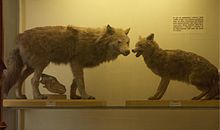
The gray wolf is the largest extant member of the Canidae, excepting certain large breeds of domestic dog. Gray wolf weight and size can vary greatly worldwide, tending to increase proportionally with latitude as predicted by Bergmann's Rule, with the large wolves of Alaska and Canada sometimes weighing 3–6 times more than their Middle Eastern and South Asian cousins. On average, adult wolves measure 105–160 cm (41–63 in) in length and 80–85 cm (32–34 in) in shoulder height. The tail is ⅔ the length of the head and body, measuring 29–50 cm (11–20 in) in length. The ears are 90–110 millimeters (3.5–4.3 in) in height, and the hind feet are 220–250 mm. The skull averages 9–11 inches in length, and 5–6 inches wide. Wolf weight varies geographically; on average, European wolves may weigh 38.5 kilograms (85 lb), North American wolves 36 kilograms (79 lb) and Indian and Arabian wolves 25 kilograms (55 lb). Females in any given wolf population typically weigh 5–10 lbs less than males.
Wolves weighing over 54 kg (120 lbs) are uncommon, though exceptionally large individuals have been recorded in Alaska, Canada, and the former Soviet Union. The heaviest recorded gray wolf in North America was killed on 70 Mile River in east-central Alaska on July 12, 1939 and weighed 79.4 kilograms (175 lb), while the heaviest recorded wolf in Eurasia was killed after World War II in Kobeliaky, Poltavskij Region, Ukrainian SSR, and weighed 86 kilograms (190 lb).
Fur
The gray wolf has very dense and fluffy winter fur, with short underfur and long, coarse guard hairs. Most of the underfur and some of the guard hairs are shed in the spring and grow back in the autumn period. The longest hairs occur on the back, particularly on the front quarters and neck. Especially long hairs are found on the shoulders, and almost form a crest on the upper part of the neck. The hairs on the cheeks are elongated and form tufts. The ears are covered in short hairs which strongly project from the fur. Short, elastic and closely adjacent hairs are present on the limbs from the elbows down to the calcaneal tendons. The winter fur is highly resistant to cold; wolves in northern climates can rest comfortably in open areas at −40° by placing their muzzles between the rear legs and covering their faces with their tail. Wolf fur provides better insulation than dog fur, and does not collect ice when warm breath is condensed against it. In warm climates, the fur is coarser and scarcer than in northern wolves. Female wolves tend to have smoother furred limbs than males, and generally develop the smoothest overall coats as they age. Older wolves generally have more white hairs in the tip of the tail, along the nose and on the forehead. The winter fur is retained longest in lactating females, though with some hair loss around their nipples. Hair length on the middle of the back is 60–70 mm. Hair length of the guard hairs on the shoulders generally does not exceed 90 mm, but can reach 110–130 mm.
Coat colour ranges from almost pure white through various shades of blond, cream, and ochre to grays, browns, and blacks. Variation in fur color tends to increase in higher latitudes. Differences in coat colour between sexes are largely absent, though females may have redder tones. Fur colour doesn't seem to serve any camouflage purpose, with some experts concluding that the blended colors have more to do with emphasizing certain gestures during interaction. Black coloured wolves (which occur through wolf-dog hybridisation) rarely occur in Eurasia, where interactions with domestic dogs have been reduced over the past thousand years due to the depletion of wild wolf populations. Black specimens are more common in North America, with about half the wolves in Yellowstone National Park being black.
Sensory abilities
The gray wolf's sense of smell is relatively weakly developed when compared to that of some hunting dog breeds, being able to detect carrion upwind no farther than 2–3 km. Because of this, it rarely manages to capture hidden hares or birds, though it can easily follow fresh tracks. Its auditory perception is sharper than that of the fox, being able to hear up to a frequency of 26 kHz, which is sufficient to register the fall of leaves in the autumn period. The urban legend that wolves fear the sound of string instruments may have a basis in fact, as captive wolves have been shown to exhibit signs of intense distress when hearing low minor chords. Its night vision exceeds that of other Canids.
Behaviour
Social and territorial behaviors

Although some wolves are solitary, most are highly gregarious animals. The basic social unit of a wolf pack is the mated pair, accompanied by the pair's adult offspring. In ideal conditions, the mated pair produces pups every year, with such offspring typically staying in the pack for 10–54 months before dispersing. The average pack consists of a family of 5–11 animals (1–2 adults, 3–6 juveniles and 1–3 yearlings), or sometimes two or three such families, with exceptionally large packs consisting of 42 wolves being known. Triggers for dispersal include the onset of sexual maturity and competition within the pack for food. A new pack is usually founded by an unrelated male and female, travelling together in search of an area devoid of other hostile packs. Wolf packs rarely adopt other wolves into their fold, and typically kill them. In the rare cases where other wolves are adopted, the adoptee is almost invariably an immature animal (1–3 years of age) unlikely to compete for breeding rights with the mated pair. In some cases, a lone wolf is adopted into a pack to replace a deceased breeder. During times of ungulate abundance (migration, calving etc.), different wolf packs may temporarily join forces.
Wolves are highly territorial animals, and generally establish territories far larger than they require to survive in order to assure a steady supply of prey. Territory size depends largely on the amount of prey available and the age of the pack's pups, tending to increase in size in areas with low prey populations or when the pups reach the age of 6 months, thus having the same nutritional needs as adults. Wolf packs travel constantly in search of prey, covering roughly 9% of their territory per day (average 25 km/d or 15 mi/d). The core of their territory is on average 35 km2 (14 sq mi), in which they spend 50% of their time. Prey density tends to be much higher in the territory's surrounding areas, though wolves tend to avoid hunting in the fringes of their territory unless desperate, due to the possibility of fatal encounters with neighboring packs. The smallest territory on record was held by a pack of six wolves in northeastern Minnesota, which occupied an estimated 33 km2 (13 sq mi), while the largest was held by an Alaskan pack of ten wolves encompassing a 6,272 km2 (2,422 sq mi) area. Wolf packs are typically settled, and usually only leave their accustomed ranges during severe food shortages.
Wolves defend their territories from other packs through a combination of scent marking, direct attacks and howling (see Communication). Scent marking is used for territorial advertisement, and involves urination, defecation and ground scratching. Scent marks are generally left every 240 metres throughout the territory on regular travelways and junctions. Such markers can last for 2–3 weeks, and are typically placed near rocks, boulders, trees or the skeletons of large animals. When scent marking and howling fail to deter strange wolf packs from entering another's territory, violent interactions can ensue. Territorial fights are among the principal causes of wolf mortality: one study on wolf mortality in Minnesota and the Denali National Park and Preserve concluded that 14–65% of wolf deaths were due to predation by other wolves.
Reproduction and development
The gray wolf is generally monogamous, with mated pairs usually remaining together for life, unless one of the pair dies. Upon the death of one mated wolf, pairs are quickly re-established. Since males often predominate in any given wolf population, unpaired females are a rarity. If a dispersing male wolf is unable to establish a territory or find a mate, he mates with the daughters of already established breeding pairs from other packs. Such wolves are termed " Casanova wolves" and, unlike males from established packs, they do not form pair bonds with the females they mate with. Some wolf packs may have multiple breeding females this way, as is the case in Yellowstone National Park.
The age of first breeding in wolves depends largely on environmental factors: when food is plentiful, or when wolf populations are heavily managed, wolves can rear pups at younger ages in order to better exploit abundant resources. This is further demonstrated by the fact that captive wolves have been known to breed as soon as they reach 9–10 months, while the youngest recorded breeding wolves in the wild were 2 years old. Females are capable of producing pups every year, with one litter annually being the average. Unlike the coyote, the gray wolf never reaches reproductive senescence. Estrus typically occurs in late winter, with older, multiparous females entering estrus 2–3 weeks earlier than younger females. When receptive, the female averts the base of her tail to one side, exposing the vulva. During mating, the pair is locked into a copulatory tie, which may last 5–36 minutes. The copulatory tie is caused by the swelling of the male wolf's penis inside the female's vulva. Wolves are able to separate from a copulatory tie more readily than domestic dogs. Because estrus in wolves lasts only a month, male wolves do not abandon their mates to find other females to inseminate as dogs do. During pregnancy, female wolves remain in a den located away from the peripheral zone of their territories, where violent encounters with other packs are more likely. Old females usually whelp in the den of their previous litter, while younger females typically den near their birthplace. The gestation period lasts 62–75 days, with pups usually being born in the summer period.
Wolves bear relatively large pups in small litters compared to other canid species. The average litter consists of 5–6 pups, with litter sizes tending to increase in areas where prey is abundant, though exceptionally large litters of 14–17 pups occur only 1% of the time. Pups are usually born in spring, coinciding with a corresponding increase in prey populations. Pups are born blind and deaf, and are covered in short soft grayish-brown fur. They weigh 300–500 grams at birth, and begin to see after 9–12 days. The milk canines erupt after one month. Pups first leave the den after 3 weeks. At 1.5 months of age, they are agile enough to flee from danger. Mother wolves do not leave the den for the first few weeks, relying on the fathers to provide food for them and their young. Pups begin to eat solid food at the age of 3–4 weeks. Pups have a fast growth rate during their first four months of life: during this period, a pup's weight can increase nearly 30 times. Wolf pups begin play fighting at the age of 3 weeks, though unlike young foxes and coyotes, their bites are inhibited. Actual fights to establish hierarchy usually occur at 5–8 weeks of age. This is in contrast to young foxes and coyotes, which may begin fighting even before the onset of play behaviour. By autumn, the pups are mature enough to accompany adults on hunts for large prey.
Denning and sheltering behaviour
Wolves use different places for their diurnal rest: places with cover are preferred during cold, damp and windy weather, while wolves in dry, calm and warm weather readily rest in the open. During the autumn-spring period, when wolves are more active, they willingly lie out in the open, whatever their location. Actual dens are usually constructed for pups during the summer period. When building dens, females make use of natural shelters such as fissures in rocks, cliffs overhanging riverbanks and holes thickly covered by vegetation. Sometimes, the den is the appropriated burrow of smaller animals such as foxes, badgers or marmots. An appropriated den is often widened and partly remade. On rare occasions, female wolves dig burrows themselves, which are usually small and short with 1–3 openings. Wolves do not line their denning places, a likely precaution against parasites. The den is usually constructed not more than 500 metres away from a water source, and typically faces southwards, thus ensuring enough sunlight exposure, keeping the denning area relatively snow free. Resting places, play areas for the pups and food remains are commonly found around wolf dens. The odour of urine and rotting food emanating from the denning area often attracts scavenging birds such as magpies and ravens. As there are few convenient places for burrows, wolf dens are usually occupied by animals of the same family. Though they mostly avoid areas within human sight, wolves have been known to nest near domiciles, paved roads and railways.
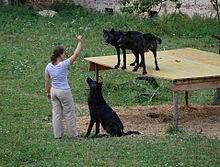
Intelligence
Although the wolf's intelligence has not been quantified, scattered reports and laboratory studies do give indications on the species' ability to remember, associate events, and learn. During the extermination of the American bison on the Great Plains, wolves learned to follow the sounds of gunshots, and would wait until the hunters had skinned and abandoned the bison carcasses before feeding on them. In northern Montana, where wolves were heavily persecuted by aerial hunters, wolves learned to avoid open areas whenever they heard aircraft. Conversely, biologists using aircraft to study wolves have managed to condition wolves not to fear their approach, even when flying low. When hunting, wolves tend to target the easiest options available to them: in areas populated by both moose and smaller deer species, the latter are taken in much higher proportion. The wolf's powers of memory were described by George Mivart, who reported that a tame wolf was able to recognise its master after a three-year absence. Non-rabid wolves are able to distinguish between armed and unarmed people, and typically avoid investigating people who display self-confident demeanors typical of being armed. Adult wolves have been known to skillfully select hidden approaches when entering their dens, using bushes, wind-fallen trees, stumps, and other natural structures to conceal their approach. Wolves with prior experience to traps may learn how to avoid or even harmlessly trigger them: in his hunt for the Currumpaw wolf, naturalist Ernest Thompson Seton noted that his initial attempts at capturing it were unsuccessful, as the wolf would dig up and spring the traps, or ignore them altogether.
Though wolves are trainable, they lack the same degree of tractability seen in dogs. They are generally not as responsive as dogs are to coercive techniques involving fear, aversive stimuli and force. Generally, far more work is required to obtain the same degree of reliability seen in most dogs. Even then, once a certain behaviour has been repeated several times, wolves may get bored and ignore subsequent commands. Wolves are more responsive toward positive conditioning and rewards, though simple praise is not sufficient as in most dogs. Unlike dogs, wolves tend to respond more to hand signals than voice. Most attempts to train wolves as working dogs have met with failure. German biologist Erik Zimen attempted to train his captive wolves as sled dogs, and although his wolves eventually accepted the harness and the need to pull the sled in a straight line, they were ultimately unreliable, as they fought for personal space, would ignore commands once tired, and were distracted by other wildlife. However, John James Audubon recorded an instance of a wolf being trained to hunt deer in Kentucky, and Henry Wharton Shoemaker published a similar account of settlers in western and central Pennsylvania using wolves as hunting dogs. Buffon wrote in his Natural History of tamed wolves in Persia being trained to perform dances and tricks.
Hunting and feeding behaviours
Although social animals, single wolves or mated pairs typically have higher success rates in hunting than do large packs, with single wolves having occasionally been observed to kill large prey such as moose, bison and muskoxen unaided. A wolf hunt can be divided into five stages:
- Locating prey: The wolves travel in search of prey through their power of scent, chance encounter, and tracking. Wolves typically locate their prey by scent, though they must usually be directly downwind of it. When a breeze carrying the prey's scent is located, the wolves stand alert, and point their eyes, ears and nose towards their target. In open areas, wolves may precede the hunt with group ceremonies involving standing nose-to-nose and wagging their tails. Once concluded, the wolves head towards their prey.
- The stalk: The wolves attempt to conceal themselves as they approach. As the gap between the wolves and their prey closes, the wolves quicken their pace, wag their tails, and peer intently, getting as close to their quarry as possible without making it flee.
- The encounter: Once the prey detects the wolves, it can either approach the wolves, stand its ground, or flee. Large prey, such as moose, elk, and muskoxen, usually stand their ground. Should this occur, the wolves hold back, as they require the stimulus of a running animal to proceed with an attack. If the targeted animal stands its ground, the wolves either ignore it, or try to intimidate it into running.
- The rush: If the prey attempts to flee, the wolves immediately pursue it. This is the most critical stage of the hunt, as wolves may never catch up with prey running at top speed. If their prey is travelling in a group, the wolves either attempt to break up the herd, or isolate one or two animals from it.
- The chase: A continuation of the rush, the wolves attempt to catch up with their prey and kill it. When chasing small prey, wolves attempt to catch up with their prey as soon as possible, while with larger animals, the chase is prolonged, in order to wear the selected prey out. Wolves usually give up chases after 1–2 km (0.62–1.3 mi), though one wolf was recorded to chase a deer for 21 km (13 mi). Both Russian and North American wolves have been observed to drive prey onto crusted ice, precipices, ravines, slopes and steep banks to slow them down.
The actual killing method varies according to prey species. With large prey, mature wolves usually avoid attacking frontally, instead focusing on the rear and sides of the animal. Large prey, such as moose, is killed by biting large chunks of flesh from the soft perineum area, causing massive blood loss. Such bites can cause wounds 10–15 cm in length, with three such bites to the perineum usually being sufficient to bring down a large deer in optimum health. With medium-sized prey such as roe deer or sheep, wolves kill by biting the throat, severing nerve tracks and the carotid artery, thus causing the animal to die within a few seconds to a minute. With small, mouse-like prey, wolves leap in a high arc and imobilize it with their forepaws. When prey is vulnerable and abundant, wolves may occasionally surplus kill. Such instances are common in domestic animals, but rare in the wild. In the wild, surplus killing primarily occurs during late winter or spring, when snow is unusually deep (thus impeding the movements of prey) or during the denning period, when wolves require a ready supply of meat when denbound. Medium-sized prey are especially vulnerable to surplus killing, as the swift throat-biting method by which they are killed allows wolves to quickly kill one animal and move on to another. Surplus killing may also occur when adult wolves are teaching their young to hunt.
Once prey is brought down, wolves begin to feed excitedly, ripping and tugging at the carcass in all directions, and bolting down large chunks of it. The breeding pair typically monopolizes food in order to continue producing pups. When food is scarce, this is done at the expense of other family members, especially non-pups. The breeding pair typically eats first, though as it is they who usually work the hardest in killing prey, they may rest after a long hunt and allow the rest of the family to eat unmolested. Once the breeding pair has finished eating, the rest of the family tears off pieces of the carcass and transport them to secluded areas where they can eat in peace. Wolves typically commence feeding by consuming the larger internal organs of their prey, such as the heart, liver, lungs and stomach lining. The kidneys and spleen are eaten once they are exposed, followed by the muscles. A single wolf can eat 15–19% of its body weight in a single feeding.
Communication
Visual
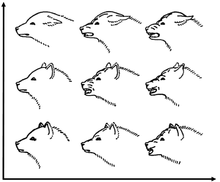
The gray wolf's expressive behaviour is more complex than that of the coyote and golden jackal, as necessitated by its group living and hunting habits. While less gregarious canids generally possess simple repertoires of visual signals, wolves have more varied signals which subtly inter grade in intensity. When neutral, the legs are not stiffened, the tail hangs down loosely, the face is smooth, the lips untensed, and the ears point in no particular direction. Postural communication in wolves consists of a variety of facial expressions, tail positions and piloerection. Aggressive, or self-assertive wolves are characterized by their slow and deliberate movements, high body posture and raised hackles, while submissive ones carry their bodies low, sleeken their fur and lower their ears and tail. When a breeding male encounters a subordinate family member, it may stare at it, standing erect and still with the tails horizontal to its spine. Two forms of submissive behaviour are recognized: passive and active. Passive submission usually occurs as a reaction to the approach of a dominant animal, and consists of the submissive wolf lying partly on its back and allowing the dominant wolf to sniff its anogenital area. Active submission occurs often as a form of greeting, and involves the submissive wolf approaching another in a low posture, and licking the other wolf's face. When wolves are together, they commonly indulge in behaviors such as nose pushing, jaw wrestling, cheek rubbing and facial licking. The mouthing of each other's muzzles is a friendly gesture, while clamping on the muzzle with bared teeth is a dominance display.
| Feature | Aggressive | Fearful |
|---|---|---|
| Eyes | Direct stare Open wide |
Looking away Closed to slits |
| Ears | Erect and forward | Flattened and turned down to side |
| Lips | Horizontal contraction ("agonistic pucker") |
Horizontal retraction ("submissive grin") |
| Mouth | Opened | Closed |
| Teeth | Canines bared | Canines covered |
| Tongue | Retracted | Extended ("lick intention") |
| Nose | Shortened (skin folded) | Lengthened (skin smoothed) |
| Forehead | Contracted (bulging over eyes) | Stretched (smoothed) |
| Head | Held high | Lowered |
| Neck | Arched | Extended |
| Hair | Erect (bristled) | Sleeked |
| Body | Erect/tall | Crouched/low |
| Tail | Held high Quivering |
Tucked under body Wagging |
Auditory
Howling
 |
Wolves howling
|
| Problems listening to this file? See media help. | |
 |
Rallying cry
|
| Problems listening to this file? See media help. | |
Wolves howl to assemble the pack (usually before and after hunts), to pass on an alarm (particularly at a den site), to locate each other during a storm or unfamiliar territory and to communicate across great distances. Wolf howls can under certain conditions be heard over areas of up to 130 km2 (50 sq mi). Wolf howls are generally indistinguishable from those of large dogs. Male wolves give voice through an octave, passing to a deep bass with a stress on "O", while females produce a modulated nasal baritone with stress on "U". Pups almost never howl, while yearling wolves produce howls ending in a series of dog-like yelps. Howling consists of a fundamental frequency which may lie between 150 and 780 Hz, and consists of up to 12 harmonically related overtones. The pitch usually remains constant or varies smoothly, and may change direction as many as four or five times. Howls used for calling pack mates to a kill are long, smooth sounds similar to the beginning of the cry of a horned owl. When pursuing prey, they emit a higher pitched howl, vibrating on two notes. When closing in on their prey, they emit a combination of a short bark and a howl. When howling together, wolves harmonize rather than chorus on the same note, thus creating the illusion of there being more wolves than there actually are. Lone wolves typically avoid howling in areas where other packs are present. Wolves do not respond to howls in rainy weather and when satiated. Wolves from different geographic locations may howl in different fashions: the howls of European wolves are much more protracted and melodious than those of North American wolves, whose howls are louder and have a stronger emphasis on the first syllable. The two are however mutually intelligible, as North American wolves have been recorded to respond to European-style howls made by biologists.
Other vocalizations
Other vocalisations of wolves are usually divided into three categories: growls, barks and whines. Barking has a fundamental frequency between 320–904 Hz, and is usually emitted by startled wolves. Wolves do not bark as loudly or continuously as dogs do, but bark a few times and retreat from perceived danger. Growling has a fundamental frequency of 380–450 Hz, and is usually emitted during food challenges. Pups commonly growl when playing. One variation of the howl is accompanied by a high pitched whine, which precedes a lunging attack. Whining is associated with situations of anxiety, curiosity, inquiry and intimacy such as greeting, feeding pups and playing.
Olfactory
Olfaction is probably the wolf's most acute sense, and plays a fundamental role in communication. The wolf has a large number of apocrine sweat glands on the face, lips, back, and between the toes. The odour produced by these glands varies according to the individual wolf's microflora and diet, giving each a distinct "odour fingerprint". A combination of apocrine and eccrine sweat glands on the feet allows the wolf to deposit its scent whilst scratching the ground, which usually occurs after urine marking and defecation during the breeding season. The follicles present on the guard hairs from the wolf's back have clusters of apocrine and sebaceous glands at their bases. As the skin on the back is usually folded, this provides a microclimate for bacterial propagation around the glands. During piloerection, the guard hairs on the back are raised and the skin folds spread, thus releasing scent. The pre-caudal scent glands may play a role in expressing aggression, as combative wolves raise the base of their tails whilst drooping the tip, thus positioning the scent glands at the highest point. The wolf possesses a pair of anal sacs beneath the rectum, which contain both apocrine and sebaceous glands. The components of anal sac secretions vary according to season and gender, thus indicating that the secretions provide information related to gender and reproductive state. The secretions of the preputial glands may advertise hormonal condition or social position, as dominant wolves have been observed to stand over subordinates, apparently presenting the genital area for investigation. During the breeding season, female wolves secrete substances from the vagina which communicate the females' reproductive state, and can be detected by males from long distances. Urine marking is the best-studied means of olfactory communication in wolves. Its exact function is debated, though most researchers agree that its primary purpose is to establish boundaries. Wolves urine mark more frequently and vigorously in unfamiliar areas, or areas of intrusion, where the scent of other wolves or canids is present. So-called raised leg urination (RLU) is more common in male wolves than in females, and may serve the purpose of maximizing the possibility of detection by conspecifics, as well as reflect the height of the marking wolf. Only dominant wolves typically use RLU, with subordinate males continuing to use the juvenile standing posture throughout adulthood.
Ecology
Diet
The gray wolf generally specializes in vulnerable individuals of large prey. In Eurasia, many wolf populations are forced to subsist largely on livestock and garbage in areas with dense human activity, though wild ungulates such as moose, red deer, roe deer and wild boar are still the most important food sources in Russia and the more mountainous regions of Eastern Europe. Other prey species include reindeer, argali, mouflon, wisent, saiga, ibex, chamois, wild goats, fallow deer and musk deer. The prey animals of North American wolves have largely continued to occupy suitable habitats with low human density, and cases of wolves subsisting largely on garbage or livestock are exceptional. Animals preferred as prey by North American wolves include moose, white-tailed deer, elk, mule deer, bighorn sheep, Dall's sheep, American bison, muskox and caribou.
Although wolves primarily feed on medium to large sized ungulates, they are not fussy eaters. Smaller sized animals that may supplement the diet of wolves include marmots, hares, badgers, foxes, weasels, ground squirrels, mice, hamsters, voles and other rodents, as well as insectivores. They frequently eat waterfowl and their eggs. When such foods are insufficient, they prey on lizards, snakes, frogs, rarely toads and large insects as available. In times of scarcity, wolves readily eat carrion, visiting cattle burial grounds and slaughter houses. Cannibalism is not uncommon in wolves: during harsh winters, packs often attack weak or injured wolves, and may eat the bodies of dead pack members. Wolf packs in Astrakhan hunt Caspian seals on the Caspian Sea coastline and some wolf packs in Alaska and Western Canada have been observed to feed on salmon. Humans are rarely, but occasionally preyed upon.
Wolves supplement their diet with fruit and vegetable matter: they willingly eat the berries of mountain ash, lily of the valley, bilberries, blueberries and cowberry. Other fruits include nightshade, apples and pears. They readily visit melon fields during the summer months. Wolves can survive without food for long periods: two weeks without food does not weaken a wolf's muscle activity. A well-fed wolf stores fat under the skin, around the heart, intestines, kidneys, and bone marrow, particularly during the autumn and winter. Digestion only takes a few hours, thus wolves can feed several times in one day, making quick use of large quantities of meat.
Enemies and competitors
Wolves typically dominate other canid species in areas where they both occur. In North America, incidents of wolves killing coyotes are common, particularly in winter, when coyotes feed on wolf kills. Wolves may attack coyote den sites, digging out and killing their pups, though rarely eating them. There are no records of coyotes killing wolves, though coyotes may chase wolves if they outnumber them. Near identical interactions have been observed in Eurasia and Africa between wolves and golden jackals, with the latter's numbers being comparatively small in areas with high wolf densities. Wolves are the most important predator of raccoon dogs, killing large numbers of them in the spring and summer periods. Wolves also kill red, arctic and corsac foxes, usually in disputes over carcasses, sometimes eating them. In Asia, they may compete with dholes.
Wolves encounter brown bears in both Eurasia and North America. Brown bears typically dominate wolf packs in disputes over carcasses, while wolf packs mostly prevail against bears when defending their den sites. Both species kill each other's young. Wolves eat the brown bears they kill, while brown bears seem to only eat young wolves. American black bears occur solely in the Americas. Wolf interactions with black bears are much rarer than with brown bears, due to differences in habitat preferences. The majority of black bear encounters with wolves occur in the species' northern range, with no interactions being recorded in Mexico. Wolves have been recorded on numerous occasions to actively seek out black bears in their dens and kill them without eating them. Unlike brown bears, black bears frequently lose against wolves in disputes over kills. While encounters with brown and black bears appear to be common, polar bears are rarely encountered by wolves, though there are two records of wolf packs killing polar bear cubs. Wolves also kill the cubs of Asian black bears.
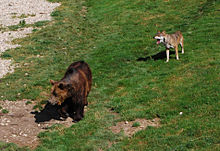
Wolves may encounter striped hyenas in Israel and Central Asia, usually in disputes over carcasses. Striped hyenas feed extensively on wolf-killed carcasses in areas where the two species interact. One-to-one, hyenas dominate wolves, but wolf packs can drive off single hyenas.
Large wolf populations limit the numbers of small to medium sized felines. Wolves encounter cougars along portions of the Rocky Mountains and adjacent mountain ranges. Wolves and cougars typically avoid encountering each other by hunting on different elevations. In winter however, when snow accumulation forces their prey into valleys, interactions between the two species become more likely. Although they rarely interact, wolves and cougars kill each other, with wolf packs sometimes usurping cougars' kills. They hunt steppe cats, and may pose a threat to snow leopards. Wolves may also reduce Eurasian lynx populations.
Other than humans, tigers appear to be the only serious predators of wolves. In areas where wolves and tigers share ranges, such as the Russian Far East, the two species typically display a great deal of dietary overlap, resulting in intense competition. Wolf and tiger interactions are well documented in Sikhote-Alin which, until the beginning of the 20th century, held very few wolves. Wolf numbers increased in the region only after tigers were largely eliminated during the Russian colonization in the late 19th and early 20th centuries. This is corroborated by native inhabitants of the region claiming that they had no memory of wolves inhabiting Sikohte-Alin until the 1930s, when tiger numbers decreased. Tigers depress wolf numbers, either to the point of localized extinction or to such low numbers as to make them a functionally insignificant component of the ecosystem. Wolves appear capable of escaping competitive exclusion from tigers only when human persecution decreases tiger numbers. Today, wolves are considered scarce in tiger inhabited areas, being found in scattered pockets, and usually seen traveling as loners or in small groups. First hand accounts on interactions between the two species indicate that tigers occasionally chase wolves from their kills, while wolves scavenge from tiger kills. Proven cases of tigers killing wolves are rare and attacks appear to be competitive rather than predatory in nature, with at least four proven records of tigers killing wolves without consuming them. This competitive exclusion of wolves by tigers has been used by Russian conservationists to convince hunters in the Far East to tolerate tigers, as they limit ungulate populations less than wolves, and are effective in controlling wolf numbers.
Range and conservation
The gray wolf was once one of the world's most widely distributed mammal, after humans and lions, living throughout the northern hemisphere north of 15°N latitude in North America and 12°N in India. Deliberate human persecution has reduced the species' range to about one third, due to livestock predation and fear over attacks on humans. The species is now extinct in much of Western Europe, in Mexico and much of the USA. In modern times, the gray wolf occurs mostly in wilderness and remote areas, particularly in Canada, Alaska and northern USA, Europe, and Asia from about 75°N to 12°N.
Wolf population declines have been arrested since the 1970s, and have fostered recolonization and reintroduction in parts of its former range, due to legal protection, changes in land-use and rural human population shifts to cities. Competition with humans for livestock and game species, concerns over the danger posed by wolves to people, and habitat fragmentation pose a continued threat to the species. Despite these threats, the gray wolf's relatively widespread range and stable population means that the species is not threatened at a global level, and is therefore classified by the IUCN as Least Concern.
Europe
Decline
The extermination of Northern Europe's wolves first became an organized effort during the Middle Ages, and continued until the late 1800s. In England, wolf persecution was enforced by legislation, and the last wolf was killed in the early sixteenth century during the reign of Henry VII. Wolves lasted longer in Scotland, where they sheltered in vast tracts of forest, which were subsequently burned down. Wolves managed to survive in the forests of Braemar and Sutherland until 1684. The extinction of wolves in Ireland followed a similar course, with the last wolf there being killed in 1770. The first wolf bounty was introduced in Sweden in 1647, after the extermination of moose and reindeer forced wolves to feed on livestock. The Sami extirpated wolves in northern Sweden in organized drives. By 1960, few wolves remained in Sweden, due to the use of snowmobiles in hunting them, with the last specimen being killed in 1966. Norway's last wolf was killed in 1973. The species was decimated in 20th century Finland, despite regular dispersals from Russia. The gray wolf was only present in the eastern and northern parts of Finland by 1900, though its numbers increased after World War II.
In Central Europe, wolves were dramatically reduced in number during the early nineteenth century, due to organized hunts and reductions in ungulate populations. The gray wolf was exterminated in Denmark in 1772, and largely disappeared in Switzerland before the end of the nineteenth century. In Bavaria, the last wolf was killed in 1847, and had disappeared from the Rhine regions by 1899. In 1934, Nazi Germany became the first state in modern history to place the wolf under protection, though the species was already extinct in Germany at this point. Wolf hunting in France was first institutionalized by Charlemagne between 800–813, when he established the louveterie, a special corps of wolf hunters. The louveterie was abolished after the French Revolution in 1789, but was re-established in 1814. In 1883, up to 1,386 wolves were killed, with many more by poison.

In Eastern Europe, wolves were never fully exterminated, due to the area's contiguity with Asia and its large forested areas. However, Eastern European wolf populations were reduced to very low numbers by the late nineteenth century. Wolves went extinct in Slovakia during the first decade of the twentieth century and, by the mid-twentieth century, could only be found in a few forested areas in eastern Poland. Wolves in the eastern Balkans benefitted from the region's contiguity with the former Soviet Union and large areas of plains, mountains and farmlands. Wolves in Hungary occurred in only half the country around the start of the 20th century, and were largely restricted to the Carpathian Basin. Wolf populations in Romania remained largely substantial, with an average of 2,800 wolves being killed annually out of a population of 4,600 from 1955–1965. An all time low was reached in 1967, when the population was reduced to 1,550 animals. The extermination of wolves in Bulgaria was relatively recent, as a previous population of about 1,000 animals in 1955 was reduced to about 100–200 in 1964. In Greece, the species disappeared from the southern Peloponnese in 1930. Despite periods of intense hunting during the eighteenth century, wolves never disappeared in the western Balkans, from Albania to the former Yugoslavia. Organized persecution of wolves began in Yugoslavia in 1923, with the setting up of the Wolf Extermination Committee (WEC) in Kocevje, Slovenia. The WEC was successful in reducing wolf numbers in the Dinaric Alps.
In Southern Europe, wolf extermination was not as complete as in Northern Europe, due to greater cultural tolerance of the species. Wolf populations only began declining in the Iberian Peninsula until the early 1800s, and was reduced by a half of its original size by 1900. Wolf bounties were regularly paid in Italy as late as 1950. Wolves were exterminated in the alps by 1800, and numbered only 100 by 1973, inhabiting only 3–5% of their former Italian range.
Recovery
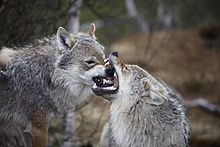
The recovery of European wolf populations began after the 1950s, when traditional pastoral and rural economies declined and thus removed the need to heavily persecute wolves. By the 1980s, small and isolated wolf populations expanded in the wake of decreased human density in rural areas and the recovery of wild prey populations.
The gray wolf has been fully protected in Italy since 1976, and now holds a population of 450–500 animals, which has an annual increase of about 60%. Italian wolves entered France's Mercantour National Park in 1993, and at least fifty wolves were discovered in the western alps in 2000. There are approximately 2000 wolves inhabiting the Iberian Peninsula, of which 150 reside in northeastern Portugal. In Spain, the species occurs in Galicia, Leon, and Asturia. Although hundreds of Iberian wolves are illegally killed annually, the population has expanded south across the river Duero and east to the Asturias and Pyrenees Mountains.
In 1978, wolves began recolonising central Sweden after a twelve-year absence, and have since expanded into southern Norway. As of 2005, the total number of Swedish and Norwegian wolves is estimated to be at least one hundred, including eleven breeding pairs. The gray wolf is fully protected in Sweden and partially controlled in Norway. The Scandinavian wolf populations owe their continued existence to neighbouring Finland's contiguity with the Republic of Karelia, which houses a large population of wolves. Wolves in Finland are protected only in the southern third of the country, and can be hunted in other areas during specific seasons, though poaching remains common, with 90% of young wolf deaths being due to human predation, and the number of wolves killed exceeds the number of hunting licenses, in some areas by a factor of two. Furthermore, the decline in the moose populations has reduced the wolf's food supply.
Wolf populations in Poland have increased to about 800–900 individuals since being classified as a game species in 1976. Poland plays a fundamental role in providing routes of expansion into neighbouring Central European countries. In the north, its range overlaps with populations in Lithuania, Belorussia, Ukraine, and Slovakia. A relatively recent population in western Poland has expanded into eastern Germany and a pack with cubs has been sighted within 15 miles of Berlin. The gray wolf is protected in Slovakia, though an exception is made for wolves killing livestock. A few Slovakian wolves disperse into the Czech Republic, where they are afforded full protection. Wolves in Slovakia, Ukraine and Croatia may disperse into Hungary, where the lack of cover hinders the buildup of an autonomous population. Although wolves have special status in Hungary, they may be hunted with a year-round permit if they cause problems.
Romania has a large population of wolves, numbering 2500 animals. The wolf has been a protected animal in Romania since 1996, although the law is not enforced. The number of wolves in Albania and Macedonia is largely unknown, despite the importance the two countries have in linking wolf populations from Greece to those of Bosnia and Croatia. Although protected, many wolves are illegally killed in Greece annually, and their future is uncertain. Wolf numbers have declined in Bosnia since 1986, while the species is fully protected in neighbouring Croatia and Slovenia.
Since 2011, Netherlands, Belgium and Denmark have also reported wolf sightings presumably by natural migration from adjacent countries.
Asia
Historical range and decline
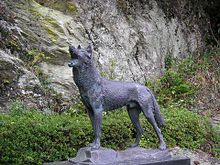
During the 19th century, wolves were widespread in many parts of the Holy Land east and west of the Jordan River. However, they decreased considerably in number between 1964 and 1980, largely due to persecution by farmers. The species was not considered common in northern and central Saudi Arabia during the 19th century, with most early publications involving animals either from southwestern Asir, northern rocky areas bordering Jodan, or areas surrounding Riyadh.
The wolf's range in the Soviet Union encompassed nearly the entire territory of the country, being absent only on the Solovetsky Islands, Franz-Josef Land, Severnaya Zemlya, and the Karagin, Commander and Shantar Islands. The species was exterminated twice in Crimea, once after the Russian Civil War, and again after World War II. Following the two world wars, Soviet wolf populations peaked twice. 30,000 wolves were harvested annually out of a population of 200,000 during the 1940s, with 40,000–50,000 harvested during peak years. Soviet wolf populations reached a low around 1970, disappearing over much of European Russia. The population increased again by 1980 to about 75,000, with 32,000 being killed in 1979. Wolf populations in northern inner Mongolia declined during the 1940s, primarily due to poaching of gazelles, the wolf's main prey. In British-ruled India, wolves were heavily persecuted due to their attacks on sheep, goats and children. In 1876, 2,825 wolves were bountied in the North-Western Provinces (NWP) and Bihar. By the 1920s, wolf extermination remained a priority in the NWP and Awadh. Overall, over 100,000 wolves were killed for bounties in British India between 1871 and 1916.
Wolves in Japan became extinct during the Meiji restoration period, an extermination known as ōkami no kujo. The wolf was deemed a threat to ranching which the Meiji government promoted at the time, and targeted via a bounty system and a direct chemical extermination campaign inspired by the similar contemporary American campaign. The last Japanese wolf was a male killed on the 23 January 1905 near Washikaguchi (now called Higashi Yoshiro).
Modern range

There is little reliable data on the status of wolves in the Middle East, save for those in Israel and Saudi Arabia, though their numbers appear to be stable, and are likely to remain so. Israel's conservation policies and effective law enforcement maintain a moderately sized wolf population, which radiates into neighbouring countries, while Saudi Arabia has vast tracts of desert, where about 300–600 wolves live undisturbed. The wolf survives throughout most of its historical range in Saudi Arabia, probably due to a lack of pastoralism and abundant human waste. Turkey may play an important role in maintaining wolves in the region, due to its contiguity with Central Asia. The mountains of Turkey have served as a refuge for the few wolves remaining in Syria. A small wolf population occurs in the Golan Heights, and is well protected by the military activities there. Wolves living in the southern Negev desert are contiguous with populations living in the Egyptian Sinai and Jordan. Throughout the Middle East, the species is only protected in Israel. Elsewhere, it can be hunted year-round by Bedouins.
Little is known of current wolf populations in Iran, which once occurred throughout the country in low densities during the mid-1970s. The northern regions of Afghanistan and Pakistan are important strongholds for the wolf. It has been estimated that there are about 300 wolves in approximately 60,000 km2 (23,000 sq mi) of Jammu and Kashmir in northern India, and 50 more in Himachal Pradesh. Overall, India supports about 800-3,000 wolves, scattered among several remnant populations. Although protected since 1972, Indian wolves are classed as Endangered, with many populations lingering in low numbers or living in areas increasingly used by humans. Although present in Nepal and Bhutan, there is no information of wolves occurring there.
Wolf populations throughout Northern and Central Asia are largely unknown, but are estimated in the hundreds of thousands based on annual harvests. Since the fall of the Soviet Union, continent-wide extermination of wolves has ceased, and wolf populations have increased to about 25,000–30,000 animals throughout the former Soviet Union. In China and Mongolia, wolves are only protected in reserves. Mongolian populations have been estimated at 10,000–30,000, while the status of wolves in China is more fragmentary. The north has a declining population of an estimated 400 wolves, while Xinjiang and Tibet hold about 10,000 and 2,000 respectively.
North America
Historical range and decline
Originally, the gray wolf occupied all of North America north of about 20°N. It occurred all over the mainland, save for the southeastern USA, California west of the Sierra Nevada, and the tropical and subtropical areas of Mexico. Large continental islands occupied by wolves included Newfoundland, Vancouver Island, southeastern Alaskan islands, and throughout the Arctic Archipelago and Greenland.
The decline of North American wolf populations coincided with increasing human populations and the expansion of agriculture. By the start of the 20th century, the species had almost disappeared from the eastern USA, excepting some areas of the Appalachians and the northwestern Great Lakes Region. In Canada, the gray wolf was extirpated in New Brunswick and Nova Scotia between 1870 and 1921, and in Newfoundland around 1911. It vanished from the southern regions of Quebec and Ontario between 1850 and 1900. The gray wolf's decline in the prairies began with the extermination of the American bison and other ungulates in the 1860s–70s. From 1900–1930, the gray wolf was virtually eliminated from the western USA and adjoining parts of Canada, due to intensive predator control programs aimed at eradicating the species. The gray wolf was exterminated by federal and state governments from all of the USA by 1960, except in Alaska and northern Minnesota. The decline in North American wolf populations was reversed from the 1930s to the early 1950s, particularly in southwestern Canada, due to expanding ungulate populations resulting from improved regulation of big game hunting. This increase triggered a resumption of wolf control in western and northern Canada. Thousands of wolves were killed from the early 1950s to the early 1960s, mostly due to poisoning. This campaign was halted and wolf populations increased again by the mid-1970s.
Modern range
The species' modern range in North America is mostly confined to Alaska and Canada, with populations also occurring in northern Minnesota, northern Wisconsin and Michigan's Upper Peninsula, and portions of Washington, Idaho, and Montana. From 1995–1996, wolves from Alberta and British Columbia were reintroduced to Yellowstone National Park and Idaho. Another reintroduction took place in Arizona and New Mexico in 1998. The gray wolf is found in approximately 80% of its historical range in Canada, thus making it an important stronghold for the species.
Canada is home to about 52,000–60,000 wolves, whose legal status varies according to province and territory. While Natives can hunt wolves without restriction, other residents require licenses. In Alaska, the gray wolf population is estimated at 6,000–7,000, and can be legally harvested during hunting and trapping seasons, with bag limits and other restrictions. As of 2002, there are 250 wolves in 28 packs in Yellowstone, and 260 wolves in 25 packs in Idaho. The gray wolf received ESA protection in Minnesota, Wisconsin, and Michigan in 1974, and was re-classed from Endangered to Threatened in 2003. Reintroduced Mexican wolves in Arizona and New Mexico are protected under the ESA and, as of late 2002, number 28 individuals in eight packs.
Africa
Up until 2011, it was debated whether or not the gray wolf occurred in Africa. Aristotle wrote of wolves living in Egypt, mentioning that they were smaller than the Greek kind. Georg Ebers wrote of the wolf being among the sacred animals of Egypt, describing it as a "smaller variety" of wolf to those of Europe, and noting how the name Lykopolis, the Ancient Egyptian city dedicated to Anubis, means "city of the wolf". Zoologist Ernst Schwarz classified North Africa's wolf-like canid as a subspecies of golden jackal, and was subsequently criticised for having overlooked its morphological affinity to the gray wolf. In December 2002, a canid was sighted in Eritrea's Danakil Desert, whose appearance didn't correspond to that of the golden jackal or the six other recognised species of the area, but strongly resembled that of the gray wolf. That the canid was a gray wolf was proven in 2011, when the base pairs of the mtDNA of samples taken from the Ethiopian Highlands were analyzed and compared with those of other wolves and wolf-like canids. The results suggested that African wolves inhabit at least two places in Ethiopia, approximately 2,500 km southeast of Egypt. A further study confirmed the presence of wolves in Algeria, Mali and Senegal.
Diseases and parasites
Because wolves travel great distances, they may play an important role in spreading and maintaining diseases in certain areas, some of which can be potentially fatal to humans. However, most gray wolf populations are remarkably resilient against outbreaks, for there are no records of wolves being decimated by disease. Usually, a wolf displaying the first symptoms of disease leaves its pack, thus preventing the sickness from spreading to its pack mates.
Viral and bacterial infections
Viral diseases carried by wolves include rabies, canine distemper, canine parvovirus, infectious canine hepatitis, papillomatosis, and canine coronavirus. Wolves are a major host for rabies in Russia, Iran, Afghanistan, Iraq and India. In wolves, the incubation period is 8–21 days, and results in the host becoming agitated, deserting its pack, and travelling up to 80 km a day, thus increasing the risk of infecting other wolves. Infected wolves do not show any fear of humans, with most documented wolf attacks on people being attributed to rabid animals. Although canine distemper is lethal in dogs, it has not been recorded to kill wolves, except in Canada and Alaska. The canine parvovirus, which causes death by dehydration, electrolyte imbalance, and endotoxic shock or sepsis, is largely surviveable in wolves, but can be lethal to pups. Wolves may catch infectious canine hepatitis from dogs, though there are no records of wolves dying from it. Papillomatosis has been recorded only once in wolves, and likely doesn't cause serious illness or death, though it may alter feeding behaviors. The canine coronavirus has been recorded in Alaskan wolves, with infections being most prevalent in winter months.
Bacterial diseases carried by wolves include brucellosis, lyme disease, leptospirosis, tularemia, bovine tuberculosis, listeriosis, anthrax and foot and mouth disease. Wolves can catch Brucella suis from wild and domestic reindeer. While adult wolves tend not to show any clinical signs, it can severely weaken the pups of infected females. Although lyme disease can debilitate individual wolves, it does not appear to have any significant effect on wolf populations. Leptospirosis can be contracted through contact with infected prey or urine, and can cause fever, anorexia, vomiting, anaemia, hematuria, icterus, and death. Wolves living near farms are more vulnerable to the disease than those living in the wilderness, probably due to prolonged contact with infected domestic animal waste. Wolves may catch tularemia from lagomorph prey, though its effect on wolves is unknown. Although bovine tuberculosis is not considered a major threat to wolves, it has been recorded to have once killed two wolf pups in Canada.
Parasitic infections
Wolves carry ectoparasites and endoparasites, with wolves in the former Soviet Union having been recorded to carry at least 50 species. Most of these parasites infect wolves without adverse effects, though the effects may become more serious in sick or malnourished specimens. Parasitic infection in wolves is of particular concern to people, as wolves can spread them to dogs, which in turn can carry the parasites to humans. In areas where wolves inhabit pastoral areas, the parasites can be spread to livestock.
Wolves are often infested with a variety of arthropod exoparasites, including fleas, ticks, lice, and mites. The most harmful to wolves, particularly pups, is Sarcoptes scabiei (or mange mite), though they rarely develop full blown mange, unlike foxes. Lice, such as Trichodectes canis, may cause sickness in wolves, but rarely death. Ticks of the genus Ixodes can infect wolves with Lyme disease and Rocky Mountain spotted fever. The tick Dermacentor pictus also infests wolves. Other ectoparasites include biting lice, sucking lice and the fleas Pulex irritans and Ctenocephalides canis.
Endoparasites known to infect wolves include protozoans and helminths ( flukes, tapeworms, roundworms and thorny-headed worms). Of 30,000 protozoan species, only a few have been recorded to infect wolves: Isospora, Toxoplasma, Sarcocystis, Babesia, and Giardia. Wolves may carry Neospora caninum, which is of particular concern to farmers, as the disease can be spread to livestock, with infected animals being 3–13 times more likely to miscarry than those not infected. Among flukes, the most common in North American wolves is Alaria, which infects small rodents and amphibians, which are eaten by wolves. Upon reaching maturity, Alaria migrates to the wolf's intestine, but harms it little. Metorchis conjunctus, which enters wolves through eating fish, infects the wolf's liver or gall bladder, causing liver disease, inflammation of the pancreas, and emaciation. Most other fluke species reside in the wolf's intestine, though Paragonimus westermani lives in the lungs. Tapeworms are commonly found in wolves, as their primary hosts are ungulates, small mammals, and fish, which wolves feed upon. Tapeworms generally cause little harm in wolves, though this depends on the number and size of the parasites, and the sensitivity of the host. Symptoms often include constipation, toxic and allergic reactions, irritation of the intestinal mucosa, and malnutrition. Infections by the tapeworm Echinococcus granulosus in ungulate populations tend to increase in areas with high wolf densities, as wolves can shed Echinoccocus eggs in their feces onto grazing areas. Wolves can carry over 30 roundworm species, though most roundworm infections appear benign, depending on the number of worms and the age of the host. Ancylostoma caninum attaches itself on the intestinal wall to feed on the host's blood, and can cause hyperchromic anaemia, emaciation, diarrhea, and possibly death. Toxocara canis, a hookworm known to infect wolf pups in utero, can cause intestinal irritation, bloating, vomiting, and diarrhea. Wolves may catch Dioctophyma renale from minks, which infects the kidneys, and can grow to lengths of 100 cm. D. renale causes the complete destruction of the kidney's functional tissue, and can be fatal if both kidneys are infected. Wolves can tolerate low levels of Dirofilaria immitis for many years without showing any ill effects, though high levels can kill wolves through cardiac enlargement and congestive hepatopathy. Wolves probably become infected with Trichinella spiralis by eating infected ungulates. Although T. spiralis isn't known to produce clinical signs in wolves, it can cause emaciation, salivation, and crippling muscle pains in dogs. Thorny-headed worms rarely infect wolves, though three species have been identified in Russian wolves: Onicola skrjabini, Macrocantorhynchus catulinus, and Moniliformis moniliformis.
Relationships with humans
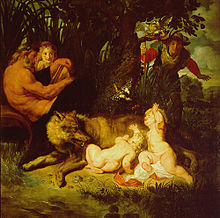
In culture
In mythology and folklore
In Norse and Japanese mythology, wolves were portrayed as near deities: in Japan, grain farmers worshiped wolves at shrines and left food offerings near their dens, beseeching them to protect their crops from wild boars and deer, while the wolf Fenrir of Norse mythology was depicted as the son of Loki. Other cultures portrayed wolves as part of their foundation myths: in Irish mythology, Cormac mac Airt is raised by wolves, while in Roman mythology, the Capitoline Wolf nurses Romulus and Remus, the future founders of Rome. In the mythology of the Turks, Mongols and Ainu, wolves were believed to be the ancestors of their people, while the Dena’ina believed wolves were once men, and viewed them as brothers. Wolves were linked to the sun in some Eurasian cultures: the Ancient Greeks and Romans associated wolves with the sun god Apollo, while the wolf Sköll in Norse mythology was depicted pursuing the setting sun. According to the Pawnee creation myth, the wolf was the first animal to experience death. Wolves were sometimes associated with witchcraft in both northern European and some Native American cultures: in Norse folkore, the völva (witch) Hyndla and the giantess Hyrrokin are both portrayed as using wolves as mounts, while in Navajo culture, wolves were feared as witches in wolf's clothing. Similarly, the Tsilhqot'in believed that contact with wolves could cause mental illness and death.
In fable and literature
In the Babylonian epic Gilgamesh, one of the oldest texts in the world, the titular character rejects the sexual advances of the goddess Ishtar, reminding her that she had transformed a previous lover, a shepherd, into a wolf, thus turning him into the very animal that his flocks must be protected against. According to the Avesta, the sacred text of the Zoroastrians, wolves are a creation of the evil spirit Ahriman, and are ranked among the most cruel of animals. Aesop featured wolves in several of his fables, playing on the concerns of Ancient Greece's settled, sheep-herding world. His most famous is the fable of The Boy Who Cried Wolf, which is directed at those who knowingly raise false alarms, and from which the idiomatic phrase " to cry wolf" is derived. Some of his other fables concentrate on maintaining the trust between shepherds and guard dogs in their vigilance against wolves, as well as anxieties over the close relationship between wolves and dogs. Although Aesop used wolves to warn, criticize and moralize about human behaviour, his portrayals added to the wolf's image as a deceitful and dangerous animal. This is mirrored in the Bible, where wolves are referenced thirteen times as symbols of greed and destructiveness. Much of the symbolism Jesus used in the New Testament revolved around the pastoral culture of Israel, and explained his relationship with his followers as analogous to that of a good shepherd protecting his flock from wolves. An innovation in the popular image of wolves started by Jesus includes the concept of the wolf in sheep's clothing, which warns people against false prophets. Several authors have proposed that Jesus's portrayal of wolves, comparing them to dangerous and treacherous people, was an important development in perceptions on the species, which legitimized centuries of subsequent wolf persecution in the western world. Subsequent medieval Christian literature followed and expanded upon Biblical teachings on the wolf. It appeared in the seventh century edition of the Physiologus, which infused pagan tales with the spirit of Christian moral and mystical teaching. The Physiologus portrays wolves as being able to strike men dumb on sight, and of having only one cervical vertebra. Dante included a she-wolf, representing greed and fraud, in the first canto of the Inferno. The Malleus Maleficarum, first published in 1487, states that wolves are either agents of God sent to punish the wicked, or agents of Satan, sent with God's blessing to test the faith of believers. Isengrim the wolf, a character first appearing in the 12th century Latin poem Ysengrimus, is a major character in the Reynard Cycle, where he stands for the low nobility, whilst his adversary, Reynard the fox, represents the peasant hero. Although portrayed as loyal, honest and moral, Isengrim is forever the victim of Reynard's wit and cruelty, often dying at the end of each story. The tale of Little Red Riding Hood, first written in 1697 by Charles Perrault, is largely considered to have had more influence than any other source of literature in forging the wolf's negative reputation in the western world. The wolf in this story is portrayed as a potential rapist, capable of imitating human speech. The hunting of wolves, and their attacks on humans and livestock feature prominently in Russian literature, and are included in the works of Tolstoy, Chekhov, Nekrasov, Bunin, Sabaneyev, and others. Tolstoy's War and Peace and Chekhov's Peasants both feature scenes in which wolves are hunted with hounds and borzois.
Farley Mowat's largely fictional 1963 memoir Never Cry Wolf was the first positive portrayal of wolves in popular literature, and is largely considered to be the most popular book on wolves, having been adapted into a Hollywood film and taught in several schools decades after its publication. Although credited with having changed popular perceptions on wolves by portraying them as loving, cooperative and noble, it has been criticized for its idealization of wolves and its factual inaccuracies. The book was later used by the Communist Party of the Soviet Union in its campaign to suppress information about wolf attacks on humans. Similar criticisms to those directed against Mowat were leveled at Misha Defonseca's Misha: A Mémoire of the Holocaust Years, in which the author falsely portrayed herself as having been a feral child raised by wolves during the Nazi occupation of Poland. Jean Craighead George's 1972 novel Julie of the Wolves, the first part in a trilogy, focuses on the relationship between a girl and a wolf pack. The last entry of the series is written from the wolves' point of view and, although anthropomorphized, the animals are crafted from a close reading of wolf biology and ethology. Several writers of modern children's literature have refashioned the image of wolves in classical fairy tales in order to portray them in a more positive light. Examples of this include Eco-wolf and the Three Little Pigs and The Wolf who cried Boy.
In heraldry and symbolism
The wolf is a frequent charge in English armory. It is illustrated as a supporter on the shields of Lord Welby, Rendel, and Viscount Wolseley, and can be found on the coat of arms of Lovett and the vast majority of the Wilsons and Lows. The demi-wolf is a common crest, appearing in the arms and crests of members of many families, including that of the Wolfes, whose crest depicts a demi-wolf holding a crown in its paws, in reference to the assistance the family gave to Charles II during the battle of Worcester. Wolf heads are common in Scottish heraldry, particularly in the coats of Clan Robertson and Skene. The wolf is the most common animal in Spanish heraldry, and is often depicted as carrying a lamb in its mouth, or across its back. The wolf is featured on the flags of the Confederated Tribes of the Colville Reservation, the Oneida Nation of Wisconsin and the Pawnee. In modern times, the wolf is widely used as an emblem for military and paramilitary groups. It is the unofficial symbol of the spetnaz, and serves as the logo of the Turkish Grey Wolves. During the Yugoslav Wars, several Serb paramilitary units adopted the wolf as their symbol, including the White Wolves and the Wolves of Vučjak.
Livestock and dog predation
Livestock depredation has been one of the primary reasons for hunting wolves, and can pose a severe problem for wolf conservation: as well as causing economic losses, the threat of wolf predation causes great stress on livestock producers, and no foolproof solution of preventing such attacks short of exterminating wolves has been found. Some nations help offset economic losses to wolves through compensation programmes or state insurance.
Domesticated animals are easy prey for wolves, as they have evolved under constant human protection, and are thus unable to defend themselves very well. Wolves typically resort to attacking livestock when wild prey is depleted: in Eurasia, a large part of the diet of some wolf populations consists of livestock, while such incidences are rare in North America, where healthy populations of wild prey have been largely restored. The majority of losses occur during the summer grazing period, with untended livestock in remote pastures being the most vulnerable to wolf predation. The most frequently targeted livestock species are sheep (Europe), domestic reindeer (northern Scandinavia), goats (India), horses (Mongolia), cattle and turkeys (North America). As wolves tend to attack large prey from behind, cattle may be more vulnerable to wolves than horses, as horses can better defend their hindquarters with powerful kicks. Different subspecies of wolf may preferentially target different animals: small bodied wolves rarely molest adult cattle, while large northern wolves are able to kill fully grown steers and sometimes horses unaided.
The number of animals killed in single attacks varies according to species: most attacks on cattle and horses result in one death, while turkeys, sheep and domestic reindeer may be killed in surplus. Wolves mainly attack livestock when the animals are grazing, though they occasionally break into fenced enclosures. Injuries caused by wolves on large-bodied livestock include docked ears and tails, and slash wounds to the lower legs. In some cases, wolves do not need to physically attack livestock to negatively affect it: the stress livestock experiences in being vigilant for wolves may result in miscarriages, weight loss and a decrease in meat quality.
Wolves kill dogs on occasion, with some wolf populations relying on dogs as an important food source. Wolves generally outmatch dogs, even large ones, in physical confrontations, because of their larger heads and teeth and stronger bites. Also, the fighting styles of wolves and dogs differ significantly: while dogs typically limit themselves to attacking the head, neck and shoulder, wolves make greater use of body blocks, and attack the extremities of their opponents. In Croatia, wolves kill more dogs than sheep, and wolves in Russia appear to limit stray dog populations. Wolves may display unusually bold behaviour when attacking dogs accompanied by people, sometimes ignoring nearby humans. Wolf attacks on dogs may occur both in house yards and in forests. On village outskirts, wolves may set up ambushes for dogs, with one wolf soliciting the dog to follow it and lead it to another wolf. Wolf attacks on hunting dogs are considered a major problem in Scandinavia and Wisconsin. The most frequently killed hunting breeds in Scandinavia are harriers, with older animals being most at risk, likely because they are less timid than younger animals, and react differently to the presence of wolves. Wolf-caused injuries on dogs are often located on the back, thighs and hind legs. The fatal wound is mostly a bite to the back of the neck. Large hunting dogs such as Swedish elkhounds are more likely to survive wolf attacks due to their better ability to defend themselves.
Attacks on humans
The fear of wolves has been pervasive in many societies, though humans are not part of the wolf's natural prey. How wolves react to humans depends largely on their prior experience with people: wolves lacking any negative experience of humans, or are food conditioned, may show little fear of people. Overall, wolves are generally not dangerous to humans, as long as they are in low numbers, have sufficient food, have little contact with humans, and are occasionally hunted.
Although wolves may react aggressively under provocation, such attacks are mostly limited to quick bites on extremities, and the attacks are not pressed. Predatory attacks (attacks by wolves treating humans as food) may be preceded by a long period of habituation, in which wolves gradually lose their fear of humans. The victims are repeatedly bitten on the head and face, and are then dragged off and consumed, unless the wolves are driven off. Such attacks typically occur only locally, and do not stop until the wolves involved are eliminated. Predatory attacks can occur at any time of the year, with a peak in the June–August period, when the chances of people entering forested areas (for livestock grazing or berry and mushroom picking) increase, though cases of non-rabid wolf attacks in winter have been recorded in Belarus, the Kirovsk and Irkutsk districts, Karelia and Ukraine. Also, wolves with pups experience greater food stresses during this period. The majority of victims of predatory wolf attacks are children under the age of 18 and, in the rare cases where adults are killed, the victims are almost always women. Wolf-dog hybrids may be bolder than pure wolves, and live on the periphery of human settlements more readily, thus making them potentially more dangerous to livestock and human life.
Cases of rabid wolves are low when compared to other species, as wolves do not serve as primary reservoirs of the disease, but can catch it from other animals such as dogs, jackals and foxes. Cases of rabies in wolves are very rare in North America, though numerous in the eastern Mediterranean, Middle East and Central Asia. Wolves apparently develop the "furious" phase of rabies to a very high degree. This, coupled with their size and strength, makes rabid wolves perhaps the most dangerous of rabid animals, with bites from rabid wolves being 15 times more dangerous than those of rabid dogs. Rabid wolves usually act alone, travelling large distances and often biting large numbers of people and domestic animals. Most rabid wolf attacks occur in the spring and autumn periods. Unlike with predatory attacks, the victims of rabid wolves are not eaten, and the attack generally only lasts a day. Also, the victims are chosen at random, though the majority of cases involve adult men.
Wolf attacks on humans were a rare, but occasional feature of life in pre-20th century Europe. In France, historical records indicate that during the period 1580–1830, 3,272 people were killed by wolves, of whom 1,961 were killed by non-rabid wolves. Church and administrative accounts from Italy indicate that 440 humans were killed by wolves during the 15th and 19th centuries, occurring in the central part of the Po Valley, which once encompassed part of modern day Switzerland. Prior to 1882, 94 children under the age of 12 were killed in Fennoscandia by non-rabid wolves in a 300 year period.
Between 1840 and 1861, 273 non-rabid attacks resulting in the deaths of 169 children and 7 adults occurred throughout Russia, while between 1944 and 1950, 22 children between the ages of 3 and 17 were killed by wolves in the Kirov Oblast (see Kirov wolf attacks). There are numerous documented accounts of wolf attacks in the Asian continent, with three Indian states reporting a large number of non-rabid attacks in recent decades. These attacks were well documented by trained biologists. In Hazaribagh, Bihar, 100 children were injured and 122 killed from 1980 to 1986.
The North American continent has very few recorded incidences of such, though the oral history of some Native American tribes confirms that wolves occasionally did kill humans. Tribes living in woodlands feared wolves more than their tundra-dwelling counterparts, as they could encounter wolves suddenly and at close quarters. It is thought that the reason why so few attacks are recorded in North America than in Eurasia is linked to the former's historically greater availability of firearms, whose usage taught North American wolves to fear humans more than their Eurasian counterparts. However, encounters with aggressive wolves in North America seem to be on the increase. One study revealed 80 events in Alaska and Canada where wolves closely approached or attacked people, finding 39 cases of aggression by apparently healthy wolves, and 29 cases of fearless behaviour by nonaggressive wolves. At least two fatal attacks by wild, non-rabid wolves have occurred in 21st century North America: in 2005, a man was killed in Saskatchewan, Canada, while in 2010, a woman was killed whilst jogging near Chignik Lake in Alaska.
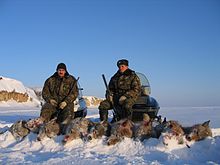
Hunting
Wolves are notoriously difficult to hunt due to their elusiveness, their sharp senses, their high endurance in the chase and ability to quickly incapacitate and kill hunting dogs. Historically, many methods have been devised to hunt wolves, including the destruction of spring-born litters in their dens, coursing with dogs (usually combinations of sighthounds, bloodhounds and fox terriers), poisoning with strychnine, and foothold and deadfall traps. A popular method of wolf hunting in Russia involves trapping a pack within a small area by encircling it with fladry poles carrying a human scent. This method relies heavily on the wolf's fear of human scents, though it can lose its effectiveness when wolves become accustomed to the smell. Some hunters are able to lure wolves by imitating their calls. In Kazakhstan and Mongolia, wolves are traditionally hunted with eagles and falcons, though this practise is declining, as experienced falconers are becoming few in number. Shooting wolves from aircraft is highly effective, as it allows greater visibility of wolves than hunting on the ground, though this method is controversial, as it allows wolves little chance to escape or defend themselves.
Uses
Wolf pelts are primarily used for scarfs and the trimmings of women's garments, though they are occasionally used for jackets, short capes, coats, mukluks and rugs. Wolf pelts tend to be thinner than those of dogs, and are more prone to tearing when sewn. The quality of wolf peltries rests on the density and strength of the fur fibre, which keeps the fur upright and gives the pelt an appealing bushy aspect. These characteristics are mostly found in northern wolf populations, but gradually lessen further south in warmer climates. North American wolf pelts are among the most valuable, as they are silkier and fluffier than Eurasian peltries. The pelts of wolves killed by poison are mostly worthless. In Medieval Europe, pelts were considered the only practical aspect of wolves, though they were seldom used, due to the skin's foul odour. In Scandinavian folklore, wolf-skin girdles assisted in transforming the wearers into werewolves, while several Native American tribes used wolf pelts for medicinal purposes. Plains Indians often wore wolf pelts as disguises to get close to American bison when hunting.
The Pawnee wore wolf skins as capes when exploring enemy territories. The United States Army used wolf skin for parkas during the later stages of WWII and the Korean War to protect the faces of soldiers from frostbite. In the Soviet Union, 30,000 wolf pelts were produced annually between 1976 and 1988. Recent statistics from CITES indicate that 6,000–7,000 wolf skins are internationally traded each year, with Canada, the former Soviet Union, Mongolia and China being the largest exporters, and the United States and Great Britain being the largest importers. Overall, the harvesting of wolves for their fur has little impact on their population, as only the northern varieties (whose numbers are stable) are of commercial value. Wolf trapping for fur remains a lucrative source of income for many Native Americans.
It is rare for wolves to be hunted for food, though historically, people have resorted to consuming wolf flesh in times of scarcity, or for medicinal reasons. Wolf meat was eaten several times during Vilhjalmur Stefansson's 1913 Arctic expedition, particularly during the summer, when wolves were fat. Natives in Transbaikalia reportedly ate wolf meat even when food was plentiful. Most Native American tribes, particularly the Naskapis, viewed wolf flesh as edible but inadequate nutrition, as it was not a herbivore and thus did not possess the same healing qualities thought to be distinct in plant eaters. The consumption of wolf flesh and organs plays an important role in Asian folk medicine: in Mongolia, eating the meat and lungs of a wolf is said to alleviate colds, and sprinkling food with powdered wolf rectum is said to cure haemorroids. Some Japanese mountain people ate wolf meat to give them courage. During the filming of The Grey, the cast members famously ate wolf meat. Accounts on how wolf meat tastes vary greatly, with descriptions ranging from "tough", "gristly", "distasteful" and "smelly", to "somewhat [resembling] chicken", and "very superior to lean venison".
Wolves as pets
Tame wolves tend to be less predictable and manageable than dogs, as they lack any alteration of their predatory behaviour, and can thus not be fully trusted in situations where their prey drive can be given adequate stimulation. Wolves are generally easier to tame than other wild canids, as they maintain infant attachments to family members and owners much longer, and also form secondary attachments to strangers much more readily. However, in contrast to dogs, which are usually accepting of strangers throughout their lives, treating them almost as an extension of their pack, wolves become increasingly xenophobic and intolerant of strangers not part of their immediate pack as they age. Despite this, the keeping of wolves as pets has grown in popularity, with an estimated 80,000-2 million privately owned wolves being present in the USA alone. While dog pups still have the ability to be socialised at up to ten weeks of age, nineteen days may be too long to wait to begin socializing a wolf pup. Because wolf milk contains more arginine than can be found in puppy milk substitutes, an arginine supplement is needed when feeding pups below the weaning age. Failure to do so can result in the pups developing cataracts. While dogs readily, and actively form social bonds with humans, wolves can only do so in the absence of adult conspecifics. Pups under one year of age are generally not aggressive toward strangers, though their aggression increases with age, particularly during the mating season. Males may be more aggressive and difficult to handle than females. Wolves are difficult to contain in standard kennels, as they exceed dogs in observational learning and are able to quickly learn how to undo latches by simply watching their handlers do so. Once wolves learn how to escape confinement, it becomes nearly impossible to contain them.


